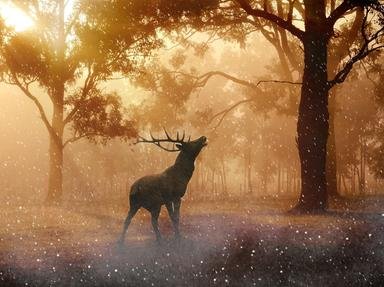Quiz Answer Key and Fun Facts
1. This tiny antelope is only about 35cm tall at the shoulders. It is slate grey in colour, with a blue-grey sheen. It has short pointed horns, just peeping out from a crest of hair. It has a wagging bushy tail, trimmed with white. The long facial glands give a hint of what type of antelope this is.
2. This is a large antelope, shiny black, with sharply contrasting white undersides and inner thighs. The long horns are transversely ridged, and sweep up and back in a pronounced curve. The face has black and white markings.
3. This medium-sized antelope is easily recognizable by the white blaze on its face. The blaze is generally broken by a brown band between the eyes. It is a medium size antelope, reddish-brown in colour, with simple lyre-shaped horns. Not to be confused with its cousin from the western cape, this antelope is found in the central open grassland regions.
4. This large antelope is much taller at the shoulder than at the rump, giving it an awkward look. It has a golden-brown colour, with black leg markings. A black blaze runs down its long pointed head. The horns are close set at the base, curve forward and out, then backwards and in, giving them a unique unusual shape.
5. This is a large dark-brown to black antelope with a long white horse-like tail, and white mane on the neck. Horns are found on both sexes, and drop steeply down, then twist forward and up. The horns on a male will form a boss over the top of the head. This antelope is found in scrub and open grasslands towards the western parts of southern Africa, and is not to be confused with its better-looking cousin.
6. This medium size antelope inhabits the open arid plains of the western parts of southern Africa. They have a dark brown side stripe separating the fawn-brown upper parts from the white underparts. They have lyrate horns. The ability to leap high into the air when running, is what gives them their name.
7. This is the largest of the small antelope species, and resembles the steenbok. The ram has erect, partially ridged horns. They have a black tipped tail. Their hindquarters are higher than the shoulders. Not very common, they are found in the north and eastern parts of southern Africa.
8. This very large antelope has a tawny colour, and straight horns with a slight spiral, on both sexes. Older bulls develop a large dewlap on the throat. Generally found in the northern parts of southern Africa, there is also a natural population in the Drakensberg.
9. The distinctive feature of this large antelope is the long rapier-like horns on both sexes. It has a thick neck, black facial and body markings and a long black horse-like tail. It occurs mainly in Namibia, but has been reintroduced to the western arid areas of South Africa.
10. This small antelope is the only antelope to walk on its hoof tips. It is wide spread throughout southern Africa, but confined to rocky areas. It is a stocky creature with a short muzzle, and sharp upright horns on the rams.
Source: Author
51percent
This quiz was reviewed by FunTrivia editor
crisw before going online.
Any errors found in FunTrivia content are routinely corrected through our feedback system.

